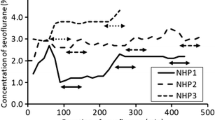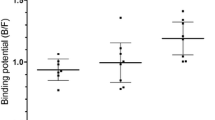Abstract
Purpose
Using positron emission tomography in isoflurane-anaesthetised cat, we recently demonstrated that the effect of d-amphetamine (AMPH) was greater on the binding potential (BPND) of the agonist dopamine D2/D3 radiotracer (+)-4-[11C]propyl-3,4,4a,5,6,10b-hexahydro-2H-naphtho[1,2-b][1, 4]oxazin-9-ol ([11C]-(+)-PHNO) than on that of the antagonist [11C]-raclopride, a finding that we were unable to replicate in conscious rat. Herein we tested whether isoflurane differentially affects the AMPH sensitivity of [11C]-(+)-PHNO and [3H]-raclopride.
Procedures
Conscious or isoflurane-anaesthetised rats pretreated intravenously (i.v.) with saline or 4 mg/kg AMPH were co-injected i.v. with [11C]-(+)-PHNO/[3H]-raclopride or [3H]-(+)-PHNO/[11C]-(−)-N-propyl-norapomorphine ([11C]-(−)-NPA) and euthanised 2, 10, 20, 30, 40 or 60 min following [11C]-(+)-PHNO/[3H]-raclopride or 60 min following [3H]-(+)-PHNO/[11C]-(−)-NPA. Striatal binding at 60 min, estimated by the specific binding ratio (SBR) and the binding potential with respect to non-displaceable binding (BPND) for pseudodynamic data, was calculated using the simplified reference tissue model.
Results
Isoflurane increased [11C]-(+)-PHNO, [3H]-(+)-PHNO and [11C]-(−)-NPA SBR (mean ± SD) by 80 ± 30%, 170 ± 50% and 120 ± 40%, and doubled the effect of AMPH on the SBR of these radiotracers to −61 ± 9%, −69 ± 12% and −60 ± 12%, respectively. Neither effect was seen for [3H]-raclopride SBR. Similar results were observed for [11C]-(+)-PHNO and [3H]-raclopride BPND.
Conclusions
Isoflurane differentially increases the binding and AMPH sensitivity of [11C]-(+)-PHNO and [11C]-(−)-NPA relative to [3H]-raclopride, suggesting that agonist radiotracers will prove no more effective for imaging dopaminergic activity in human than antagonist radiotracers.





Similar content being viewed by others
Abbreviations
- AMPH:
-
d-Amphetamine
- B max :
-
Total density of specific binding sites
- BP:
-
Binding potential
- BPF :
-
Binding potential with respect to free radiotracer in plasma
- BPND :
-
Binding potential with respect to non-displaceable binding
- DAT:
-
Dopamine transporter
- %ID/g:
-
Percent of injected dose per gram wet tissue weight
- K D :
-
Equilibrium dissociation constant
- l-DOPA:
-
3,4-dihydroxy-L-phenylalanine
- MNPA:
-
2-Methoxy-N-propyl-norapomorphine
- (−)-NPA:
-
(−)-N-propyl-norapomorphine
- PET:
-
Positron emission tomography
- (+)-PHNO:
-
(+)-4-Propyl-3,4,4a,5,6,10b-hexahydro-2H-naphtho[1,2-b][1, 4]oxazin-9-ol
- SBR:
-
Specific binding ratio
- SUV:
-
Standard uptake value
References
Tsukada H, Miyasato K, Kakiuchi T, Nishiyama S, Harada N, Domino EF (2002) Comparative effects of methamphetamine and nicotine on the striatal [11C]raclopride binding in unanesthetized monkeys. Synapse 45:207–212
Hassoun W, Le Cavorsin M, Ginovart N, Zimmer L, Gualda V, Bonnefoi F, Leviel V (2003) PET study of the [11C]raclopride binding in the striatum of the awake cat: effects of anaesthetics and role of cerebral blood flow. Eur J Nucl Med Mol Imaging 30:141–148
Tsukada H, Harada N, Nishiyama S, Ohba H, Sato K, Fukumoto D, Kakiuchi T (2000) Ketamine decreased striatal [11C]raclopride binding with no alterations in static dopamine concentrations in the striatal extracellular fluid in the monkey brain: multiparametric PET studies combined with microdialysis analysis. Synapse 37:95–103
Tsukada H, Nishiyama S, Kakiuchi T, Ohba H, Sato K, Harada N (2001) Ketamine alters the availability of striatal dopamine transporter as measured by [11C]beta-CFT and [11C]beta-CIT-FE in the monkey brain. Synapse 42:273–280
Momosaki S, Hatano K, Kawasumi Y, Kato T, Hosoi R, Kobayashi K, Inoue O, Ito K (2004) Rat-PET study without anesthesia: anesthetics modify the dopamine D1 receptor binding in rat brain. Synapse 54:207–213
Ginovart N, Galineau L, Willeit M, Mizrahi R, Bloomfield PM, Seeman P, Houle S, Kapur S, Wilson AA (2006) Binding characteristics and sensitivity to endogenous dopamine of [11C]-(+)-PHNO, a new agonist radiotracer for imaging the high-affinity state of D2 receptors in vivo using positron emission tomography. J Neurochem 97:1089–1103
Narendran R, Slifstein M, Guillin O, Hwang Y, Hwang DR, Scher E, Reeder S, Rabiner E, M Laruelle (2006) Dopamine (D2/3) receptor agonist positron emission tomography radiotracer [11C]-(+)-PHNO is a D3 receptor preferring agonist in vivo. Synapse 60:485–495
McCormick PN, Kapur S, Wilson AA (2008) Dopamine D2 receptor radiotracers [11C](+)-PHNO and [3H]raclopride are indistinguishably inhibited by D2 agonists and antagonists ex vivo. Nucl Med Biol 35:11–17
Wilson AA, DaSilva JN, Houle S (1996) In vivo evaluation of [11C]- and [18F]-labelled cocaine analogues as potential dopamine transporter ligands for positron emission tomography. Nucl Med Biol 23:141–146
Wilson AA, Garcia A, Parkes J, McCormick P, Stephenson KA, Houle S, Vasdev N (2008) Radiosynthesis and initial evaluation of [18F]-FEPPA for PET imaging of peripheral benzodiazepine receptors. Nucl Med Biol 35:305–314
Wilson AA, McCormick P, Kapur S, Willeit M, Garcia A, Hussey D, Houle S, Seeman P, Ginovart N (2005) Radiosynthesis and evaluation of [11C]-(+)-4-propyl-3, 4, 4a, 5, 6, 10b-hexahydro-2H-naphtho[1, 2-b][1, 4]oxazin-9-ol as a potential radiotracer for in vivo imaging of the dopamine D2 high-affinity state with positron emission tomography. J Med Chem 48:4153–4160
Lammertsma AA, Hume SP (1996) Simplified reference tissue model for PET receptor studies. Neuroimage 4:153–158
Narendran R, Hwang DR, Slifstein M, Talbot PS, Erritzoe D, Huang Y, Cooper TB, Martinez D, Kegeles LS, Abi-Dargham A, Laruelle M (2004) In vivo vulnerability to competition by endogenous dopamine: comparison of the D2 receptor agonist radiotracer (−)-N-[11C]propyl-norapomorphine ([11C]NPA) with the D2 receptor antagonist radiotracer [11C]-raclopride. Synapse 52:188–208
Seneca N, Finnema SJ, Farde L, Gulyas B, Wikstrom HV, Halldin C, Innis RB (2006) Effect of amphetamine on dopamine D2 receptor binding in nonhuman primate brain: a comparison of the agonist radioligand [11C]MNPA and antagonist [11C]raclopride. Synapse 59:260–269
Hwang DR, Kegeles LS, Laruelle M (2000) (−)-N-[11C]propyl-norapomorphine: a positron-labeled dopamine agonist for PET imaging of D2 receptors. Nucl Med Biol 27:533–539
Narendran R, Hwang DR, Slifstein M, Hwang Y, Huang Y, Ekelund J, Guillin O, Scher E, Martinez D, Laruelle M (2005) Measurement of the proportion of D2 receptors configured in state of high affinity for agonists in vivo: a positron emission tomography study using [11C]N-propyl-norapomorphine and [11C]raclopride in baboons. J Pharmacol Exp Ther 315:80–90
Narendran R, Slifstein M, Hwang DR, Hwang Y, Scher E, Reeder S, Martinez D, Laruelle M (2007) Amphetamine-induced dopamine release: duration of action as assessed with the D2/3 receptor agonist radiotracer (−)-N-[11C]propyl-norapomorphine [11C]NPA) in an anesthetized nonhuman primate. Synapse 61:106–109
Ohba H, Harada N, Nishiyama S, Kakiuchi T, Tsukada H (2009) Ketamine/xylazine anesthesia alters [11C]MNPA binding to dopamine D2 receptors and response to methamphetamine challenge in monkey brain. Synapse 63:534–537
Laruelle M (2000) Imaging synaptic neurotransmission with in vivo binding competition techniques: a critical review. J Cereb Blood Flow Metab 20:423–451
Galineau L, Wilson AA, Garcia A, Houle S, Kapur S, Ginovart N (2006) In vivo characterization of the pharmacokinetics and pharmacological properties of [11C]-(+)-PHNO in rats using an intracerebral beta-sensitive system. Synapse 60:172–183
Finnema SJ, Seneca N, Farde L, Shchukin E, Sovago J, Gulyas B, Wikstrom HV, Innis RB, Neumeyer JL, Halldin C (2005) A preliminary PET evaluation of the new dopamine D2 receptor agonist [11C]MNPA in cynomolgus monkey. Nucl Med Biol 32:353–360
Adachi YU, Yamada S, Satomoto M, Higuchi H, Watanabe K, Kazama T (2005) Isoflurane anesthesia induces biphasic effect on dopamine release in the rat striatum. Brain Res Bull 67:176–181
Opacka-Juffry J, Ahier RG, Cremer JE (1991) Nomifensine-induced increase in extracellular striatal dopamine is enhanced by isoflurane anaesthesia. Synapse 7:169–171
Laruelle M, Guo N, Guo W, Jiang M, Schieren A, Abi-Dargham A, Javitch JA, Rayport S (2008) Impact of dopamine D2 receptor internalization on binding parameters of D2 PET radiotracers. Neuroimage 41:T36
Guo N, Guo W, Kralikova M, Jiang M, Schieren I, Narendran R, Slifstein M, Abi-Dargham A, Laruelle M, Javitch JA, Rayport S (2010) Impact of d2 receptor internalization on binding affinity of neuroimaging radiotracers. Neuropsychopharmacology 35:806–817
Skinbjerg M, Liow JS, Seneca N, Hong J, Lu S, Thorsell A, Heilig M, Pike VW, Halldin C, Sibley DR, Innis RB (2010) D2 dopamine receptor internalization prolongs the decrease of radioligand binding after amphetamine: a PET study in a receptor internalization-deficient mouse model. Neuroimage 50:1402–1407
Vickery RG, von Zastrow M (1999) Distinct dynamin-dependent and -independent mechanisms target structurally homologous dopamine receptors to different endocytic membranes. J Cell Biol 144:31–43
von Zastrow M (2001) Role of endocytosis in signalling and regulation of G-protein-coupled receptors. Biochem Soc Trans 29:500–504
Seeman P, Tallerico T, Ko F (2004) Alcohol-withdrawn animals have a prolonged increase in dopamine D2High receptors, reversed by general anesthesia: relation to relapse? Synapse 52:77–83
Seeman P, Tallerico T, Ko F, Tenn C, Kapur S (2002) Amphetamine-sensitized animals show a marked increase in dopamine D2 high receptors occupied by endogenous dopamine, even in the absence of acute challenges. Synapse 46:235–239
McCormick PN, Kapur S, Reckless GE, Wilson AA (2009) Ex vivo [11C]-(+)-PHNO binding is unchanged in animal models displaying increased high-affinity states of the D2 receptor in vitro. Synapse 63:998–1009
Cumming P, Wong DF, Gillings N, Hilton J, Scheffel U, Gjedde A (2002) Specific binding of [11C]raclopride and N-[3H]propyl-norapomorphine to dopamine receptors in living mouse striatum: occupancy by endogenous dopamine and guanosine triphosphate-free G protein. J Cereb Blood Flow Metab 22:596–604
McCormick PN, Kapur S, Reckless GE, Wilson AA (2009) Ex vivo [11C]-(+)-PHNO binding is unchanged in animal models displaying increased high-affinity states of the D2 receptor in vitro. Synapse 63:998–1009
Bancroft GN, Morgan KA, Flietstra RJ, Levant B (1998) Binding of [3H]PD 128907, a putatively selective ligand for the D3 dopamine receptor, in rat brain: a receptor binding and quantitative autoradiographic study. Neuropsychopharmacology 18:305–316
Kaichi Y, Nonaka R, Hagino Y, Watanabe M (2000) Dopamine D3 receptor binding by D3 agonist 7-OH-DPAT (7-hydroxy-dipropylaminotetralin) and antipsychotic drugs measured ex vivo by quantitative autoradiography. Can J Physiol Pharmacol 78:7–11
Landwehrmeyer B, Mengod G, Palacios JM (1993) Differential visualization of dopamine D2 and D3 receptor sites in rat brain. A comparative study using in situ hybridization histochemistry and ligand binding autoradiography. Eur J Neurosci 5:145–153
Levant B (1998) Differential distribution of D3 dopamine receptors in the brains of several mammalian species. Brain Res 800:269–274
Levesque D, Diaz J, Pilon C, Martres MP, Giros B, Souil E, Schott D, Morgat JL, Schwartz JC, Sokoloff P (1992) Identification, characterization, and localization of the dopamine D3 receptor in rat brain using 7-[3H]hydroxy-N, N-di-n-propyl-2-aminotetralin. Proc Natl Acad Sci USA 89:8155–8159
Rabiner E, Raymond R, Diwan M, McCormick P, Wilson A, Nobrega J (2007) D3 and D2 components of ex vivo regional (+)-PHNO brain binding in wild-type and knock-out mice. J Nucl Med 48:113P
Ginovart N, Sun W, Wilson AA, Houle S, Kapur S (2004) Quantitative validation of an intracerebral beta-sensitive microprobe system to determine in vivo drug-induced receptor occupancy using [11C]raclopride in rats. Synapse 52:89–99
Acknowledgments
The authors would like to thank Armando Garcia and Winston Stableford for radiochemical synthesis of [11C]-(+)-PHNO and [11C]-(−)-NPA and Jun Parkes and Neil Vasdev for their assistance with the animal experiments. The work in this study was financially supported the Canadian Institutes of Health Research (MOP 74702).
Conflict of Interest
The authors declare that they have no conflict of interest.
Author information
Authors and Affiliations
Corresponding author
Additional information
Significance: This article provides direct evidence that the elevated d-amphetamine sensitivity of the dopamine D2/D3 receptor agonist radiotracers [11C]-(+)-PHNO and [11C]-(−)-NPA (relative to the antagonist radiotracer [11C]-raclopride) is due to the confounding effects of isoflurane anaesthesia, rather than to considerations of the affinity state of the radiotracers’ binding sites as has been argued elsewhere (vide infra).
Rights and permissions
About this article
Cite this article
McCormick, P.N., Ginovart, N. & Wilson, A.A. Isoflurane Anaesthesia Differentially Affects the Amphetamine Sensitivity of Agonist and Antagonist D2/D3 Positron Emission Tomography Radiotracers: Implications for In Vivo Imaging of Dopamine Release. Mol Imaging Biol 13, 737–746 (2011). https://doi.org/10.1007/s11307-010-0380-3
Published:
Issue Date:
DOI: https://doi.org/10.1007/s11307-010-0380-3




